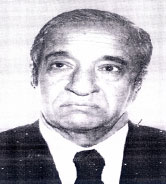M.J. Thirumalachar : 1914-1999 
In the passing away of M.J. Thirumalachar on 21 April 1999 at Walnut Creek, CA, USA, the world of biological sciences has lost a veteran researcher of over 60 years whose original contribution embraced a wide spectrum of scientific disciplines like botany, mycology, microbiology, antibiotic fermentations and chemotherapy of human, animal and plant infections. Best known as an outstanding mycologist of international standing, his contributions to the study of Indian fungi have been phenomenal. Through his publications on several new genera and species of fungi belonging to all the major groups of the mycological kingdom, Thirumalachar has indeed placed his footprints firmly on the sands of time. His earlier contributions monographing the rusts published jointly with B.B. Mundkar, description of new genera of smuts like Mundukurella, Narasimhania and Franzpetrakia (along with M.S. Pavgi) and Georgefischeria (Along with M.J. Narasimhan, M.C. Srinivasan and H.C. Govindu), erecting Sclerophthora as a new genus of downy mildew for the destructive crazy top of corn and other graminaceous hosts (along with M.J. Narasimhan and Charles Garner Shaw), establishing the morphological basis for differentating Entomophthora from Conidiobolus on the basis of cultural studies (Along with M.C. Srinivasan and M.J. Narasimhan) and the studies on the life cycle of an edible rust causing malformation on Acacia eburnea and identifying it as Ravenelia esculenta (along with M.J. Narasimhan) rediscovered sixty years after Barcklay had described Aecidium esculentum from Maharashtra are just a few examples of his most notable contributions to mycology.
In the field of antibiotics, Thirumalachar is well recognized for his discovery of Hamycin, Dermostatin and Aureofungin which are potent antifungal antibiotics therapeutically useful in the control of human mycoses and combating fungal diseases of plants. An anti-protozoal, anti-helminthic antibiotic from a new species of Emericellopsis isolated by him was designated Antiamoebln and shown to successfully control intestinal parasites in milch cattle. He continued active research leading to the discovery of bioactive compounds after he went over to the United States and established the Jeersannidhi-Anderson Institute at Walnut Creek, California along with his son M.J. Narasimhan Jr. Among his major contributions are the development of new derivatives of established antibiotic with better performance and lesser toxicity designated JAIMYCIN Inc. He also focussed on chemical control of plant and animal diseases and patented Phyton 27 as a non-phytotoxic systemic fungicide which was successfully applied for the control of Dutch elm disease and other tree wilts. Thirumalachar also developed chemotherapeutants for the control of a wide range of fungal, bacterial and mycoplasma diseases of crop plants and fruit trees and several of these have been in various stages of development and evaluation leading to eventual commercialization. Thirumalachar was an inspiring teacher and his keen interest and ability to spot unusual specimens during field collections was unique. During the early years when Mundkar visited Bangalore after he had received several new and interesting specimens from Thirumalachar, he was pleasantly surprised that they were all collected in the neighbourhood of Malleswaram or Yeswanthpur in Bangalore through careful field observation and Mundkur exclaimed that it is the eye behind, which is more important for discovery than the location. Even in his screening for new antibiotics and metabolites, Thirumalachar isolated some of the most promising and interesting cultures from Pimpri soil where the Hindustan Antibiotics Ltd. is located. The new actinomycete genus Chainia about which he published in Nature (1955) and the antifungal Hamycin producer which he designated as new species Streptomyces pimprina are just two examples of his outstanding discoveries. He has perhaps contributed more than anyone else to enriching our knowledge of microbial biodiversity in the Indian subcontinent and also showed their biotechnology potential as sources of novel and useful secondary metabolites. Thirumalachar was elected to the Fellowship of the Indian National Science Academy in 1966 and was a Council Member from 1969-1971. He was a recipient of the Sundar Lal Hora medal in 1969. He received the S.S. Bhatnagar Memorial award in 1967 for his outstanding contributions in developing therapeutically useful antifungal antibiotics. He was president of the Indian Phytopathological Society and also the first president of the Mycological Society of India when it was established in 1973. He was a member of the Editorial Board of the International Journal of Antibiotics published from Japan and established Hindustan Antibiotics Bulletin as a full-fledged scientific journal with contributions from eminent national and international scientists.
An era has ended but his contributions live on to inspire generations of biologists not only to emulate the scientific success he achieved but also to develop the interest and commitment to basic biological science and in particular mycology and microbiology. Personally speaking, he had been a dear maternal uncle, an inspired teacher and the source of every bit of scientific knowledge that I have acquired over the year and his absence is too difficult to accept.
M.C. Srinivasan
Biochemical Sciences Division,
National Chemical Laboratory,
Pune-411 008, India
